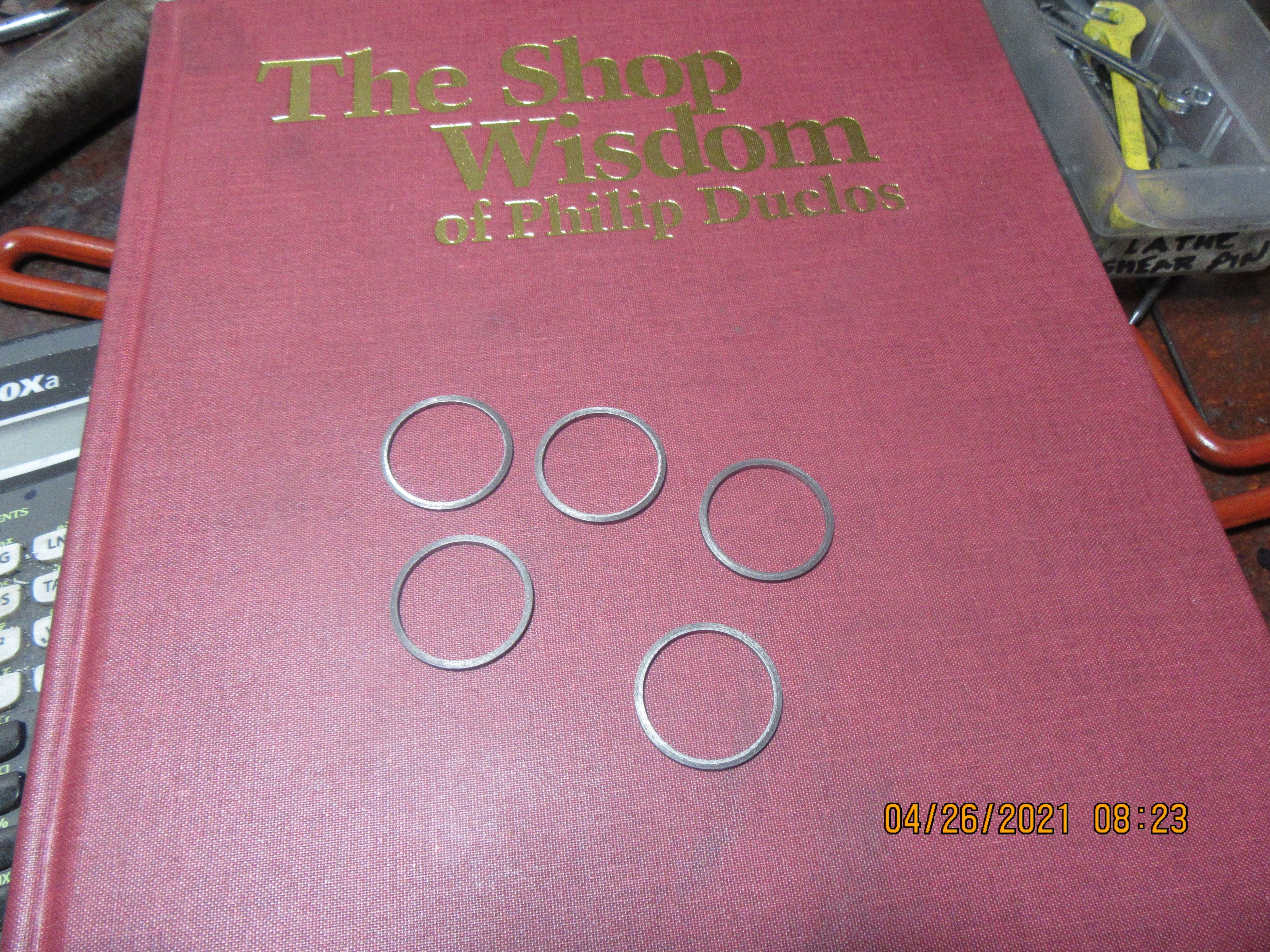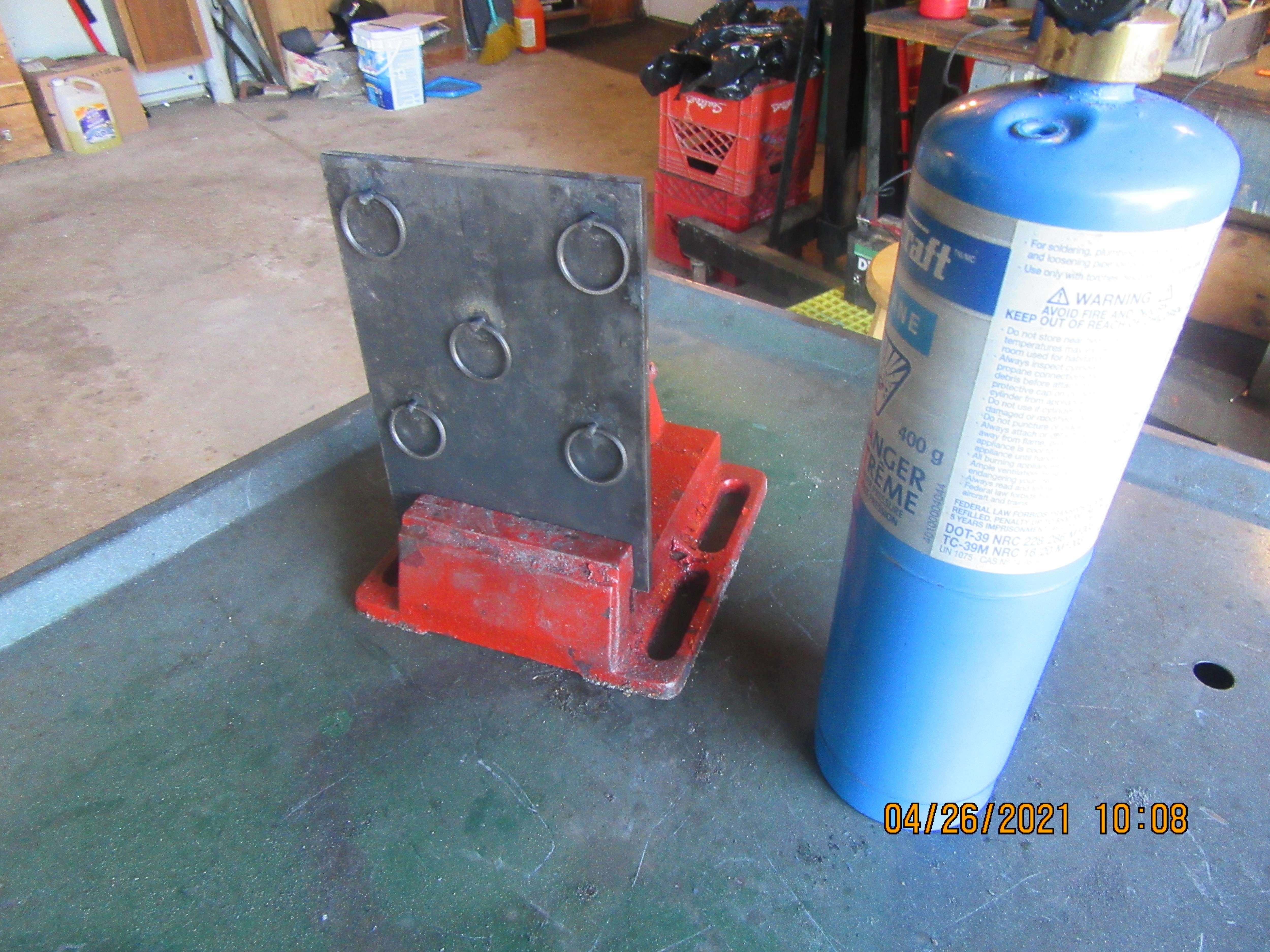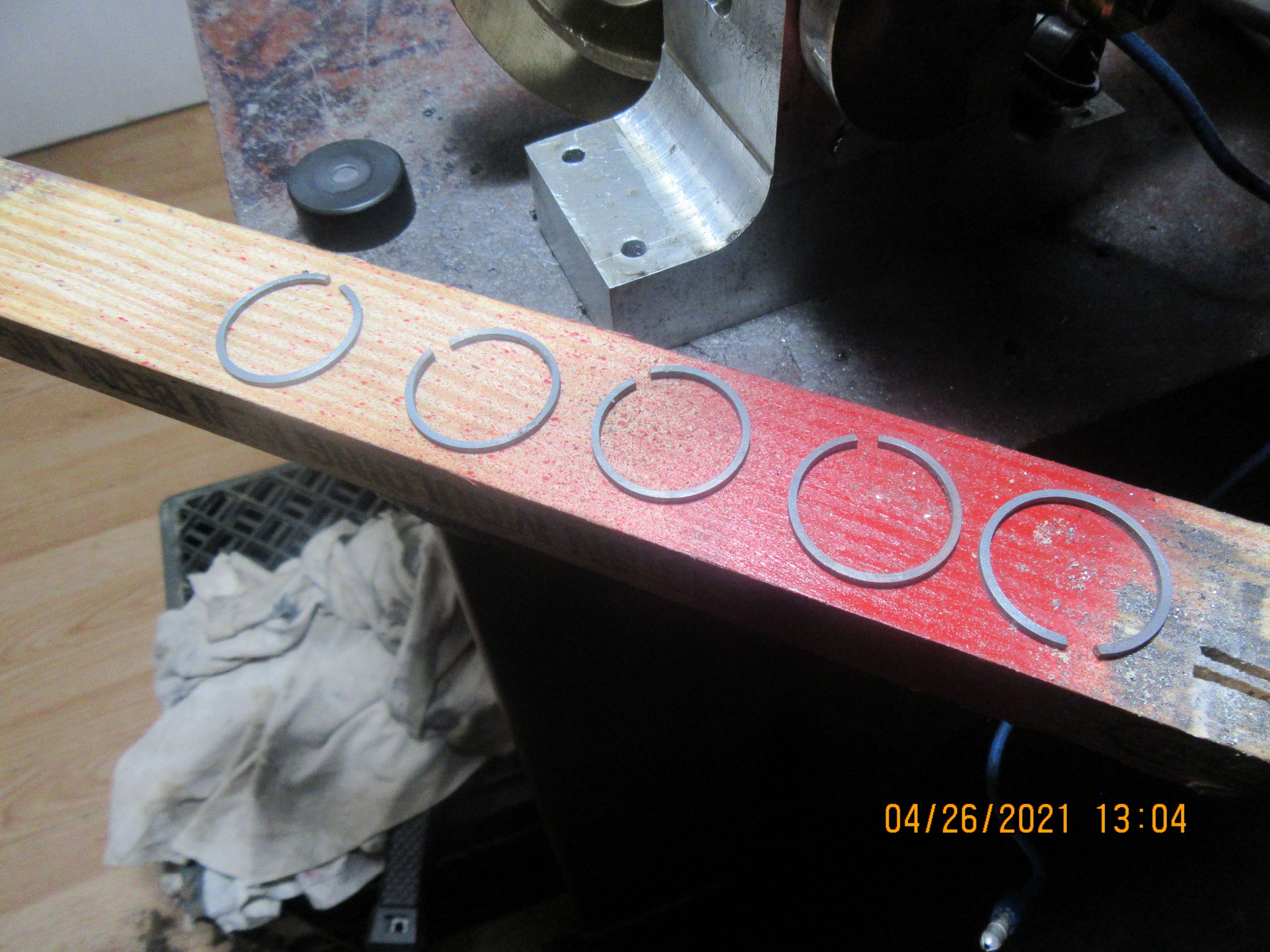And to close out the day---When these rings were pushed squarely into the cylinder, they had a 0.004" gap, without me having to do any filing on them.---Amazing!!! Then with much breath holding, butt clenching, and #30 lubricating oil, the rings were installed on the piston. They were much harder to get on the piston than the previous set I had made. I was sure I was going to break them, but they did slide on, very reluctantly, and snuggled down into the ring grooves on the piston. The next question was "Will the piston fit into a 1" bore with these new rings on it?" I have a round piece of cast iron with a 1" reamed hole through it, and a 20 degree tapered lead to help compress the rings while the piston is persuaded to fit into it. It did fit. Not easily, but it did. Tomorrow I am going to put this new piston and rings into my Rupnow Vertical Engine and hope it will run. I did start it today, as can be seen in the video, so with nothing changed except the piston and rings I am off to bed. Wish me luck for tomorrow!!!---Brian
You are using an out of date browser. It may not display this or other websites correctly.
You should upgrade or use an alternative browser.
You should upgrade or use an alternative browser.
A new attempt at making piston rings
- Thread starter Brian Rupnow
- Start date

Help Support Home Model Engine Machinist Forum:
This site may earn a commission from merchant affiliate
links, including eBay, Amazon, and others.
Piston and newest set of cast iron rings has been installed on my old Rupnow Vertical Engine. I am getting firing and smoke from exhaust but it's not a self runner yet. This is promising though. I never even got firing on the sideshaft hit and miss engine when I had the piston and rings on it. I have it set up with the electric motor right now, and I'll give it an hour and a half to help bed the rings in. If that doesn't work, I will pull the cylinder off and hone it to give a cross-hatch pattern on the inside of the cylinder.
- Joined
- Dec 31, 2010
- Messages
- 822
- Reaction score
- 220
If the rings were turned 1.006 then they certainly are NOT going to be round when you put them into a 1" bore. The fact that a 20thou gap closed to .004 should tell you that.
Again. Maybe I missed something in your description.
When the rings are turned over diameter there is another procedure and more fixtures to make to turn them round again.
Make the light mask I mentioned before to check for gaps before you run those rings in your cylinder and risk damaging it.
Never mind. You just posted while I was typing and I see you've gone ahead anyway.
Again. Maybe I missed something in your description.
When the rings are turned over diameter there is another procedure and more fixtures to make to turn them round again.
Make the light mask I mentioned before to check for gaps before you run those rings in your cylinder and risk damaging it.
Never mind. You just posted while I was typing and I see you've gone ahead anyway.
Dsage--I'm not discounting your help. I have three books here, authored by Philip Duclos, Malcolm Stride, and L. C. Mason, plus help from George Britnell. All are "more or less" the same information. I know about the "light mask" you are referring to. I am learning, but it is a very slow process.-----Brian
- Joined
- Dec 31, 2010
- Messages
- 822
- Reaction score
- 220
OK. Soldier on.
Thanks.
Thanks.
Hi Brian !
I think you re-measure the heights of the rings and grooves.
Because with both the small engine ( homemade) and the big engine ( car..), changing the new rings never causes the engine to be too heavy to start.
I think you re-measure the heights of the rings and grooves.
Because with both the small engine ( homemade) and the big engine ( car..), changing the new rings never causes the engine to be too heavy to start.

$26.89
$34.99
Peachtree Woodworking Supply Bowl Sander Tool Kit w/Dual Bearing Head & Hardwood Handle, 42 Pieces Wood Sander Set, 2 Hook & Loop Sanding Disc Sandpaper Assortment, 1/4 Mandrel Bowl Sander
Peachtree Woodworking Supply Inc
![DreamPlan Home Design and Landscaping Software Free for Windows [PC Download]](https://m.media-amazon.com/images/I/51kvZH2dVLL._SL500_.jpg)
$0.00
DreamPlan Home Design and Landscaping Software Free for Windows [PC Download]
Amazon.com Services LLC

$19.15
$29.95
Competition Engine Building: Advanced Engine Design and Assembly Techniques (Pro Series)
MBC Inc.

$599.00
$649.00
FoxAlien Masuter Pro CNC Router Machine, Upgraded 3-Axis Engraving All-Metal Milling Machine for Wood Acrylic MDF Nylon Carving Cutting
FoxAlien Official

$104.99
Sunnytech Hot Air Stirling Engine Motor Steam Heat Education Model Toy Kit M16-CF
stirlingtechonline

$39.14
$49.99
Becker CAD 12 3D - professional CAD software for 2D + 3D design and modelling - for 3 PCs - 100% compatible with AutoCAD
momox Shop

$171.00
$190.00
Genmitsu CNC 3018-PRO Router Kit GRBL Control 3 Axis Plastic Acrylic PCB PVC Wood Carving Milling Engraving Machine, XYZ Working Area 300x180x45mm
SainSmart Official

$99.99
AHS Outdoor Wood Boiler Yearly Maintenance Kit with Water Treatment - ProTech 300 & Test Kit
Alternative Heating & Supplies
After being ran by the electric motor for 1 1/2 hours, the compression has improved, and when I try to start the motor with my electric drill it fires right along as the drill turns it under power, but when I remove the drill the motor just runs down and quits. The inside of the cylinder was a mirror finish from running it so many times with a Viton o-ring on it.--So---I pulled the cylinder off and set it up on my mill with a 3 stone brake-cylinder hone, and gave it 20 linear strokes with lots of wd40 at about 100 rpm. This has removed the mirror finish and left a herringbone hone pattern on the inside of the cylinder. Now the engine is out in the garage being "run in" with an electric motor for another hour to see if the compression will come up after an hours running.
The cross hatching didn't really help at all. At this point in the game I've tried everything I can think of, and had no real success.---Ah Poop!!! So----What did I learn today? Well, for one thing, the heat from an oxy-acetylene torch is way too hot. I barely touched the rings with the flame and they immediately turned bright yellow and fell off the 1/8" steel spreaders they were hanging from. That can't be right. Tomorrow I will buy a refill for my propane cylinder, and hopefully use a cooler flame to heat treat any future rings. What else--Well, although the rings I am waiting on from Debolt are 1/16" thick, the actual rule of thumb for home made rings is that they should be from 1/25 to 1/30 of the bore diameter. I have a 1" bore, so the rings should be from 0.040" thick to 0.033" thick. That is one heck of a big difference from 1/16". In his book "The Shop wisdom of Philip Duclos", he gives a tutorial on making piston rings, and he arbitrarily chose a radial ring thickness of 0.050" and it worked well for him. If it worked for him, then it should work for me. I think I have one stub of fine grained cast iron left, so maybe tomorrow I'll make some rings using Philip Duclos' measurements.
Last edited:
- Joined
- Jan 4, 2011
- Messages
- 1,441
- Reaction score
- 403
I think that you either have to follow the Timbrel method which you have not done or you have to make the rings oversize and make a fixture to turn them to final size. Your method is not making a true round ring when it is inserted into the engine. Also based on my recent experience the heat treating is critical. I made some rings which I had heated to 1100 and then let cool and they did not seal properly. I took some more of the same batch and heated them to 1100 for three hours and left them in the kiln overnight and those worked. Maybe that was just blind luck, True round is more critical when you are making 1" dia rings as opposed to large 3" dia automotive rings.
I just found an article which says that the width of the spreader used in the heat treat fixture should be 15% of the bore diameter. In my case that would be 0.150" (For a 1" bore). That is slightly less than the 3/16" used in the Duclos' book and slightly more than the 1/8" which I used today.
dnalot
Project of the Month Winner !!!
1100 for three hours and left them in the kiln overnight and those worked
When I made George Brintnell's Holt 75 George talked me out of using o-rings and suggested the Timbrel method. I heated my rings to a little over 1100 degrees F for an hour in my foundry furnace and let them cool over night in the furnace. They turned out well and I had good compression even before breaking in.
Mark T
doc1955
Gone
- Joined
- Aug 26, 2009
- Messages
- 1,261
- Reaction score
- 168
I know my longer videos don't seem to be liked but here is a video anyway on heat treat and how not to put a ring on lol now this it for a .750 bore. When I finished the engines it took a little bit to get them running but ran just fine with them after I gt the timing and fuel mixer sorted out.
- Joined
- Dec 31, 2010
- Messages
- 822
- Reaction score
- 220
doc1955:
Unfortunately you didn't cover what outside diameter you turned the rings to in the first place.
Perhaps you can elaborate.
Unfortunately you didn't cover what outside diameter you turned the rings to in the first place.
Perhaps you can elaborate.
This morning I got up and machined 5 new rings from a piece of grey cast iron to 1.006" o.d. x 0.906" i.d. x 0.055" thick. I'm going up to the local hardware and buy a tank of propane. When cut with a 0.020" slitting saw heat treated and and taken down to 0.050" thick on some emery paper on a flat surface they will be exactly as built in the Philip Duclos book. I will recut new ring grooves on my test piston and then see what happens.


- Joined
- Dec 31, 2010
- Messages
- 822
- Reaction score
- 220
Sorry to interfere with your process. And yes I see your book. Lots of bad information is out there. The Trimble method is the defacto "correct" way of making rings.
But I will re-iterate that a ring that is turned 1.006 diameter CANNOT BE ROUND when you squash it to put it into a 1.000 cylinder regardless of what you do with the gap.
Think about it a bit and I think you'll see that. At best the ring will touch at only two points beside the gap and the point directly across the cylinder from the gap.
If that process worked you could make all your blanks one diameter and squash them into any size cylinder and call it good by making the appropriate gap. Not so.
You need to turn the rings EXACTLY the diameter of the cylinder first.
i.e It starts out round at the exact cylinder diameter and returns round and the exact same diameter with a bit of spring from the heat treating and a gap for expansion on heating. The gap is only there for installation and to make space for expansion. NOT to allow for deforming an oversized ring into a small cylinder.
Unless you are following the Chaddock method where you make a jig to take the 6thou off after you heat treat the ring to make it 1.000 and round afterward. I haven't looked at the Duclose method but you never mentioned making any extra jigs.
Also you have now worn your cylinder with the previous bad rings so you're starting from a bad place.
I'll leave it at that.
But I will re-iterate that a ring that is turned 1.006 diameter CANNOT BE ROUND when you squash it to put it into a 1.000 cylinder regardless of what you do with the gap.
Think about it a bit and I think you'll see that. At best the ring will touch at only two points beside the gap and the point directly across the cylinder from the gap.
If that process worked you could make all your blanks one diameter and squash them into any size cylinder and call it good by making the appropriate gap. Not so.
You need to turn the rings EXACTLY the diameter of the cylinder first.
i.e It starts out round at the exact cylinder diameter and returns round and the exact same diameter with a bit of spring from the heat treating and a gap for expansion on heating. The gap is only there for installation and to make space for expansion. NOT to allow for deforming an oversized ring into a small cylinder.
Unless you are following the Chaddock method where you make a jig to take the 6thou off after you heat treat the ring to make it 1.000 and round afterward. I haven't looked at the Duclose method but you never mentioned making any extra jigs.
Also you have now worn your cylinder with the previous bad rings so you're starting from a bad place.
I'll leave it at that.
Last edited:
-I'm making this set exactly to Philip Duclos's book, "The shop Wisdom of Philip Duclos". The only real difference between this set of rings and the last set is that these rings are only 0.050" thick and are spread on 0.150" pins, ready for heat treat.


doc1955
Gone
- Joined
- Aug 26, 2009
- Messages
- 1,261
- Reaction score
- 168
doc1955:
Unfortunately you didn't cover what outside diameter you turned the rings to in the first place.
Perhaps you can elaborate.
The dia of the rings I cut I use the formula to calculate the circumference then add the slitting saw width then turn the sum back into a dia. That formula has worked for all the engines I have built so I know it works.
I am using the formula that Doc talks about in the previous post. That is the formula given in "The Shop Wisdom of Philip Duclos"
This is the third batch of rings immediately after heat treat. I bought a new cylinder of propane, and there is a huge difference in the heat from a propane torch and that of an oxy acetylene rig. It took longer to heat each ring to a cherry red and it gave me a chance to heat the rings more uniformly before they dropped off the 0.150" diameter spreaders they were mounted to. Next step will be to deburr the inside and outside and bring the sides down to a uniform 0.050" thick.


doc1955
Gone
- Joined
- Aug 26, 2009
- Messages
- 1,261
- Reaction score
- 168
Thats right there is a lot of bad info on the net. Now for one thing you need to get the thought of the ring bending in one spot lol that is not the case it will bend and deform on the entire circumference thus it will be round. Rings when installed bend on the intire circumference not in abit here and a bit there that is where you are making your mistake. So Brian keep it up you are on the right path.Sorry to interfere with your process. And yes I see your book. Lots of bad information is out there. The Trimble method is the defacto "correct" way of making rings.
But I will re-iterate that a ring that is turned 1.006 diameter CANNOT BE ROUND when you squash it to put it into a 1.000 cylinder regardless of what you do with the gap.
Think about it a bit and I think you'll see that. At best the ring will touch at only two points beside the gap and the point directly across the cylinder from the gap.
If that process worked you could make all your blanks one diameter and squash them into any size cylinder and call it good by making the appropriate gap. Not so.
You need to turn the rings EXACTLY the diameter of the cylinder first.
i.e It starts out round at the exact cylinder diameter and returns round and the exact same diameter with a bit of spring from the heat treating and a gap for expansion on heating. The gap is only there for installation and to make space for expansion. NOT to allow for deforming an oversized ring into a small cylinder.
Unless you are following the Chaddock method where you make a jig to take the 6thou off after you heat treat the ring to make it 1.000 and round afterward. I haven't looked at the Duclose method but you never mentioned making any extra jigs.
Also you have now worn your cylinder with the previous bad rings so you're starting from a bad place.
I'll leave it at that.
Similar threads
- Replies
- 17
- Views
- 4K
- Replies
- 5
- Views
- 3K
- Replies
- 11
- Views
- 1K


















































